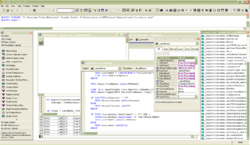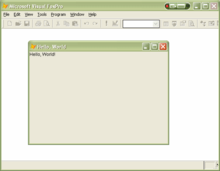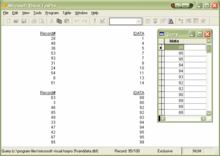- Visual FoxPro
-
"VFP" redirects here. For the floating-point extension of ARM processors, see ARM architecture#VFP.

Typical VFP9 editing sessionOriginal author(s) Microsoft Corporation Stable release Visual FoxPro 9.0 Service Pack 2 (SP2) / October 11, 2007 Development status Maintenance mode Operating system Microsoft Windows Platform x86 and greater Available in IDE: English, German, Spanish
Runtime: Above, French, Chinese, Russian, Czech, KoreanType Database Programming language License Microsoft EULA Website msdn.microsoft.com/vfoxpro Visual FoxPro is a data-centric object-oriented and procedural programming language produced by Microsoft. It is derived from FoxPro (originally known as FoxBASE) which was developed by Fox Software beginning in 1984. Fox Technologies merged with Microsoft in 1992, after which the software acquired further features and the prefix "Visual". The last version of FoxPro (2.6) worked under Mac OS, DOS, Windows, and Unix: Visual FoxPro 3.0, the first "Visual" version, reduced platform support to only Mac and Windows, and later versions were Windows-only. The current version of Visual FoxPro is COM-based and Microsoft has stated that they do not intend to create a Microsoft .NET version.
FoxPro originated as a member of the class of languages commonly referred to as "xBase" languages, which have syntax based on the dBase programming language. Other members of the xBase language family include Clipper and Recital. (A history of the early years of xBase can be found in the dBase article.)
Visual FoxPro, commonly abbreviated as VFP, is tightly integrated with its own relational database engine, which extends FoxPro's xBase capabilities to support SQL query and data manipulation. Unlike most database management systems, Visual FoxPro is a full-featured, dynamic programming language that does not require the use of an additional general-purpose programming environment. It can be used to write not just traditional "fat client" applications, but also middleware and web applications.
Contents
Recent history
In late 2002, it was demonstrated that Visual FoxPro can run on Linux under the Wine Windows compatibility suite. In 2003, this led to complaints by Microsoft: it was claimed that the deployment of runtime FoxPro code on non-Windows machines violates the End User License Agreement.[1]
In December 2005, VFP broke into the top 20 on Tiobe index[2] for the first time. In March 2007 it was at position 19, making it a "B" language. As of August, 2010, VFP (combined with xBase) is at position 25.
In March 2007, Microsoft announced that there will be no VFP 10[3], thus making VFP9 (released to manufacturing on December 17, 2004) the last commercial VFP release from Microsoft. The support of Version 9 is ongoing with service packs that were released December 8, 2005 and October 11, 2007.
At the time of the end of life announcement, work on the next release codenamed Sedna (named after a recently discovered dwarf planet) which was built on top of the VFP9 codebase had already begun. "Sedna" is a set of add-ons to VFP 9.0 of xBase components to support a number of interoperability scenarios with various Microsoft technologies including SQL Server 2005, .NET Framework, Windows Vista, Office 2007, Windows Search and Team Foundation Server (TFS). Microsoft released Sedna under the Shared source license on the CodePlex site. Microsoft has clarified that the VFP core will still remain closed source. Sedna was released on January 25, 2008[4]. As of March 2008, all xBase components of the VFP 9 SP2 (including Sedna) were available for community-development on CodePlex.
In late March 2007 a grassroots campaign was started by the Spanish-speaking FoxPro community at MasFoxPro[5] ("MoreFoxPro" in English) to sign a petition to Microsoft to continue updating Visual FoxPro or release it to the community as Open Source. On April 3, 2007 the movement was noted by the technical press[6]
Also on April 3, 2007 Microsoft responded to the petitioner's requests with this statement from Alan Griver:
"We're very aware of the FoxPro community and that played a large part in what we announced on March 13th. It's never an easy decision to announce that we're not going to release another version of a product and it's one that we consider very carefully.
"We're not announcing the end of FoxPro: Obviously, FoxPro applications will continue to work. By some of our internal estimates, there are more applications running in FoxPro 2.6 than there are in VFP and FoxPro 2.6 hasn't been supported in many years. Visual FoxPro 9 will be supported by Microsoft through 2015.
"For Microsoft to continue to evolve the FoxPro base, we would need to look at creating a 64-bit development environment and that would involve an almost complete rewrite of the core product. We've also invested in creating a scalable database with SQL Server, including the freely available SQL Server Express Edition. As far as forming a partnership with a third-party is concerned, we've heard from a number of large FoxPro customers that this would make it impossible for them to continue to use FoxPro since it would no longer be from an approved vendor. We felt that putting the environment into open source on CodePlex, which balances the needs of both the community and the large customers, was the best path forward."
Version information
Operating system compatibility
Supported Windows Versions Version VFP 3.0 VFP 5.0 VFP 6.0 VFP 7.0 VFP 8.0 VFP 9.0 Windows 3.x Yes No No No No No Windows NT 4.0 Yes Yes Yes Yes No No [7] Windows 95 Yes Yes Yes Runtime only No No Windows 98 Yes Yes Yes Yes Runtime only Runtime only Windows Me Yes Yes Yes Yes Runtime only Runtime only Windows 2000 Yes Yes Yes Yes Yes Yes Windows XP Yes Yes Yes Yes Yes Yes Windows Server 2003 ? ? Yes Yes Yes Yes Windows Vista Compatibility Mode Yes Yes Yes Yes Yes Windows 7 Yes No Yes Yes Yes Yes Information on executable files
Version VERSION() returns EXE Size EXE Date DLL Size DLL Name VFP 9 SP2 with Hotfixes Visual FoxPro 09.00.0000.7423 for Windows 5,648 kb April 3, 2009 4,624 kb VFP9R.DLL VFP 9 SP2 Visual FoxPro 09.00.0000.5721 for Windows 5,648 kb September 21, 2007 4,624 kb VFP9R.DLL VFP 9 Visual FoxPro 09.00.0000.2412 for Windows 5,620 kb December 13, 2004 4,600 kb VFP9R.DLL VFP 8 Visual FoxPro 08.00.0000.3117 for Windows 5,236 kb September 25, 2003 4,200 kb VFP8R.DLL VFP 7 Visual FoxPro 07.00.0000.9465 for Windows 4,260 kb January 4, 2002 3,344 kb VFP7R.DLL VFP 6 Visual FoxPro 06.00.8961.00 for Windows 4,091 kb August 18, 2000 3,295 kb VFP6R.DLL VFP 5 Visual FoxPro 5.0.0.415 for Windows 4,065 kb January 24, 1997 3,148 kb VFP500.DLL VFP 3 Visual FoxPro 03.00.00.0711 for Windows 4,374 kb December 16, 1995 3,657 kb VFP300.ESL FPW 2.6a FoxPro 2.6a for Windows 2,444 kb September 28, 1994 2,946 kb FOXW2600.ESL Code samples
The FoxPro language contains commands quite similar to other programming languages such as Basic. Loops include do, if, while, for, else commands in a usage easily understood by anyone familiar with other programming languages. Commands take the form of "command" and "endcommand"
Some basic syntax samples:
FOR i = 1 to 10 x = x + 6.5 ENDFOR IF i = 25 i = i + 1 ELSE i = i + 3 ENDIF x = 1 DO WHILE x < 50 x = x + 1 ENDDO
The language also has extensive database manipulation and indexing commands. The "help" index of commands in VFP 9 has several hundred commands and functions described. The examples below show how to code the creation and indexing of tables, however VFP has table and database builder screens which create the tables and indexes without making you write code.
Hello World example:
MESSAGEBOX("Hello World")
Object
loForm = CREATEOBJECT("HiForm") loForm.Show(1) DEFINE CLASS HiForm AS Form AutoCenter = .T. Caption = "Hello, World" ADD OBJECT lblHi as Label WITH ; Caption = "Hello, World!" ENDDEFINE
loMine = CREATEOBJECT("MyClass") ? loMine.cProp1 && This will work. (Double-ampersand marks an end-of-line comment) ? loMine.cProp2 && Program Error: Property CPROP2 is not found. ? loMine.MyMethod1() && This will work. ? loMine.MyMethod2() && Program Error: Property MYMETHOD2 is not found. DEFINE CLASS MyClass AS Custom cProp1 = "My Property" && This is a public property HIDDEN cProp2 && This is a private (hidden) property PROCEDURE Init() && Class constructor This.cProp2 = "This is a hidden property." ENDPROC PROCEDURE MyMethod1() * This is a public method, calling a hidden method that returns * the value of a hidden property. RETURN This.MyMethod2() ENDPROC HIDDEN PROCEDURE MyMethod2() && This is a private (hidden) method RETURN This.cProp2 ENDPROC ENDDEFINE
Data handling
&& Create a table CREATE TABLE randData (iData I) && Populate with random data using xBase and SQL DML commands FOR i = 1 TO 50 APPEND BLANK REPLACE iData WITH (RAND() * 100) INSERT INTO randData (iData) VALUES (RAND() * 100) ENDFOR && Place a structural index on the data INDEX ON iData TAG iData CLOSE ALL && Display ordered data using xBase-style commands USE randData SET ORDER TO iData GO TOP LIST NEXT 10 && First 10 GO BOTTOM SKIP -10 LIST REST && Last 10 CLOSE ALL && Browse ordered data using SQL DML commands SELECT * ; FROM randData ; ORDER BY iData DESCENDING
ODBC access using SQL passthrough
&& Connect to an ODBC data source LOCAL nHnd nHnd = SQLCONNECT ("ODBCDSN", "user", "pwd") && Execute a SQL command LOCAL nResult nResult = SQLEXEC (nHnd, "USE master") IF nResult < 0 MESSAGEBOX ("MASTER database does not exist!") RETURN ENDIF && Retrieve data from the remote server and stores it in && a local data cursor nResult = SQLEXEC (nHnd, "SELECT * FROM authors", "QAUTHORS") && Update a record in a remote table using parameters PRIVATE cAuthorID, cAuthorName cAuthorID = "1001" cAuthorName = "New name" nResult = SQLEXEC (nHnd, "UPDATE authors SET auth_name = ?cAuthorName WHERE auth_id = ?cAuthorID") && Close the connection SQLDISCONNECT(nHnd)
Beta code names
- VFP 3 - Taz
- VFP 5 - RoadRunner
- VFP 6 - Tahoe
- VFP 7 - Sedona
- VFP 8 - Toledo
- VFP 9 - Europa
- VFP Next - Sedna
References
- ^ Visual FoxPro for Linux: A Violation of the EULA?, May 13, 2003, By Ed Leafe, Linux Journal
- ^ Tiobe Index History for FoxPro
- ^ A Message to the Community
- ^ Microsoft SEDNA download
- ^ MasFoxPro
- ^ Developers petition Microsoft to reconsider FoxPro phase out Posted by Mary Jo Foley (April 3rd, 2007) - All about Microsoft - ZDNet.com
- ^ - The free patch for VFP 9.0 has been created by the German FoxPro User Group (dFPUG) and is available at the dFPUG document portal in the directory http://portal.dfpug.de/dFPUG/Dokumente/Freeware/. It allows you to run VFP 9.0 applications on NT 4.0. Microsoft has indicated that this will be addressed in VFP 9.0 SP1.
External links
Microsoft pages
- Main Visual FoxPro Microsoft page
- MSDN FoxPro support board
- VFP's online help
- Microsoft VFP 9 support
- Visual FoxPro Downloads page
Other pages
- Visual FoxPro Wiki A repository of FoxPro information (written in VFP)
- A site devoted to the history of FoxPro
- VFPx A Visual FoxPro Community effort to create open source add-ons for VFP 9.0
Implementations dBase · Clipper · Visual Objects · Visual FoxPro · Harbour Project · XBase++ · Flagship · xHarbour · Recital · Vulcan.NET · Cule.Net · CLIP · VP-InfoFrameworks IDE Tools Mediator · DBFView · Advantage Database Server · EasyReport · Clip2WinProgramming languages - Comparison
- Timeline
- Categorical list
- Generational list
- Alphabetical list
- Non-English-based
Microsoft development tools Development
environmentsOthersLanguages and
compilersVisual Basic · Visual Basic .NET · Visual C++ · Visual C# · Visual J# · Visual FoxPro · IronPython · IronRuby · PowerShell · XAML · F#Major APIs and
frameworksWindows API / SDK · .NET Framework · Managed code frameworks (Presentation · Communication · Workflow · CardSpace) · Silverlight · XNA · ASP.NET (ASP.NET AJAX) · LINQ · ADO.NET · DirectX (Managed DirectX) · Xbox Development KitDatabase tools
and languagesSQL servicesOtherSource control Deployment Driver development Performance Analysis Categories:- 4GL
- Data-centric programming languages
- Object-oriented programming languages
- XBase programming language family
- Procedural programming languages
- Desktop database application development tools
- Microsoft development tools
- Microsoft database software
- Programming languages created in 1984
Wikimedia Foundation. 2010.


